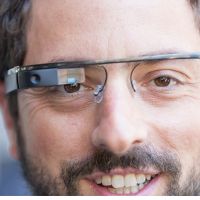Woman Gets Ticket for Driving Distracted with Google Glass
 Google co-founder Sergey Brin
Google co-founder Sergey Brin
The California Highway Patrol (CHP) tossed up a small roadblock to Google’s vision of the future when it ticketed a Temecula woman Tuesday for driving distracted because of the Google Glass she was wearing. It may be the first time a driver was ticketed for wearing the high-tech apparatus.
Cecilia Abadie, a Google Glass test participant, was pulled over for speeding, but the officer added driving distracted to the ticket, which Abadie posted online. The ticket reads in part: “Driving with Monitor visible to Driver (Google Glass).”
Google Glass is a wearable computer device that allows hands-free access to information that is displayed on a lens strapped to the user’s head. It lets users make telephone calls, send emails, snap photos and perform tasks as yet unknown using voice-operated commands and hand movements.
One of the potential uses of the device is incorporation of the technology into automobile windshields. Patent Bolt reviewed a Google patent application in May that would extend the technology to windshields, telescopes and beyond.
Projection of essential driving information, like vehicle speed, on the windshield could conceivably be safer than a driver glancing away from the road to a dashboard, but watching the Lakers game while you drive might not be. The patent also sketches out potential Google Glass use in motorcycle helmet visors, microscopes, camera finders, binoculars and telescopes.
But first, Google has to get past the cops.
California’s Vehicle Code 27602 prohibits a person from driving a motor vehicle “if a television receiver, a video monitor, or a television or video screen, or any other similar means of visually displaying a television broadcast or video signal that produces entertainment or business applications, is operating and is located in the motor vehicle at a point forward of the back of the driver’s seat, or is operating and the monitor, screen, or display is visible to the driver while driving the motor vehicle.”
The law does not apply to GPS, a mapping display, vehicle information display and a host of other displays if they come installed on the car and meet other specifications. In other words, it’s complicated.
Delaware, Maryland, West Virginia, Arizona and the United Kingdom have considered passing laws banning the use of Glass on the road. But the law and the technology are in embryonic stages and it remains to be seen how Glass will fare.
But Wired magazine has already anointed Glass as the killer app for cars, declaring, “With Google Glass in-car obsolescence is now obsolete.” The end of obsolescence aside, Wired listed a host of real-time advantages for drivers wearing Glass: dashboard info without looking away from the road, access to unseen diagnostics built into cars, assessments of fuel-efficient driving and alerts when heads bob from drowsiness.
And then there is this: “Slap on Glass and record video of your high-speed hijinks, with G-forces and cornering data overlaid on the display. Then upload it to YouTube when you’re back in the pits.”
There is no end to the possibilities.
–Ken Broder
To Learn More:
In a First, Police Ticket a Driver Wearing Google Glass (by Damon Lavrinc, Wired)
Woman Cited for Driving with Google Glass (by Mike Freeman, U-T San Diego)
California Woman Gets ticket for Driving with Google Glass (by Russell Brandom, The Verge)
California Woman Ticketed while Driving with Google Glass (by Sara Gates, Huffington Post)
Google Patent Reveals Vision for Google "Glass" Technology Extending to Windshields, Telescopes & Beyond (Patent Bolt)
- Top Stories
- Controversies
- Where is the Money Going?
- California and the Nation
- Appointments and Resignations
- Unusual News
- Latest News
- California Forbids U.S. Immigration Agents from Pretending to be Police
- California Lawmakers Urged to Strip “Self-Dealing” Tax Board of Its Duties
- Big Oil’s Grip on California
- Santa Cruz Police See Homeland Security Betrayal in Use of Gang Roundup as Cover for Immigration Raid
- Oil Companies Face Deadline to Stop Polluting California Groundwater





